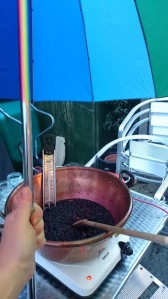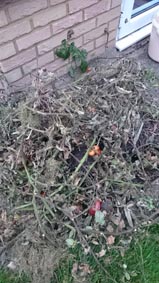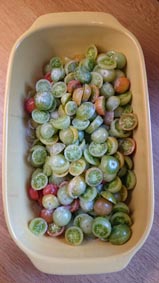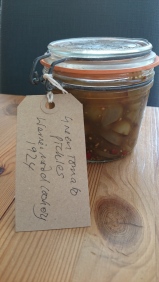Another James Martin: Home Comforts-related post, this time about carrot jam, the recipe for which I have had several requests. I first cooked carrot jam for a laugh. A friend emailed me the recipe for it as published in an 1858 copy of the English Domestic Woman’s Magazine. The EDWM was one of Samuel Beeton’s titles, and Isabella Beeton, of The Book of Household Management fame, cut her culinary writing teeth within its pages. She compiled a column called ‘Cookery, Pickling and Preserving’, out of which would eventually come the idea of the Book of Household Management. It’s still the best known historic recipe book in Britain, and had never been out of print, despite its many, many flaws. One thing is does have going for it is that it does tend to have a recipe for everything, including carrot jam. Beeton’s version, which will either have been plagiarised, as per most of ‘her’ recipes or, possibly, given it appeared first in the EDWM, sent in by a reader, is a rare thing when it comes to her recipes – it’s brilliant. Plus, the instructions are spot on. She tells you straight that it won’t last without brandy: it doesn’t. Blue mould, folks! Here’s her recipe.
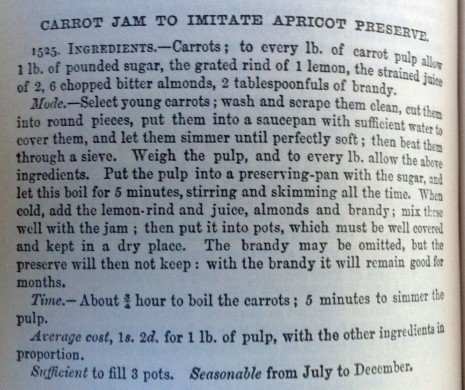
This is classic mock cookery, and it works, If you don’t tell people it’s carrot jam, they will ponder, purse their lips, and eventually guess at apricot, mainly because it looks orange (and the almonds and brandy are confusing). It’s also indicative of a strong tradition of lower class cookery which isn’t always talked about as much as middle and upper class cuisine now. We tend to rely on books as sources for recipes. Cookery books are usually aspirational and/or didactic, and they rarely reflect the everyday – just think about whether any one, or indeed, several, cookery books on your own shelves, taken out of context and without you saying things like ‘I’ve never cooked that’, or ‘I don’t use that recipe because I’ve got one in my head that’s better’, would give an accurate view of what you eat over the course of a week. Plus, the stuff that’s fancy is more interesting for people to watch on TV.
Carrot jam is a very practical recipe. No need for expensive fruit – sugar is pretty cheap by the end of the 19th century – and carrots glut and don’t keep that well. And it’s tasty, so everyone’s a winner. The recipe knocks about for a while, but disappears from the 1930s editions of Beeton and, we can only presume, the wider culinary repertoire (if it was ever part of most people’s repertoire, which is impossible to tell. The fact a recipe is in a book is no guarantee it was ever cooked). Then comes the Second World War and, with it, rationing, the Dig for Victory campaign and a massive carrot glut. Cue carrot madness. The Ministry of Food wanted people to eat the glut, so promoted carrot recipes through the various channels at their command – The Kitchen Front on the BBC, the official pamphlets, and by spreading the rumour that carrots help you see in the dark. They encouraged the idea that that was how Allied bomber pilots were so accurate in night flying, which also helped muddy the waters of exactly how far advanced experiments with radar were. Meanwhile, to help with gluts of fruit, extra sugar rations were available for jam making…the stage was set for a carrot jam comeback!
Whenever I cook carrot jam, I’m greeted with nostalgia and cries of ‘that’s a wartime recipe’. And so it is – but the wartime version was a adaptation of a somewhat earlier recipe. (The same is true of many rationing recipes – poverty cooking has always made use of grown or foraged ingredients, and ever lacked fat, sugar and meat). The wartime version omitted the brandy and the almonds, and just contained sugar and carrots. There’s slightly less sugar to carrot pulp, and the lemon flavour was provided by lemon essence, or boiling apple peel in a bag.
The version I made for James Martin: Home Comforts, was the wartime one, which can be found here, on the website of the endlessly fascinating World Carrot Museum. If you really want to make it at home though, I’d recommend the Beeton one above, substituting a few drops of almond essence (check the label and try and get bitter almond essence) for the bitter almonds, (which can be challenging to obtain due to the bit where they contain cyanide). I’d also suggest using jam sugar (the stuff with added pectin), so that you get a decent set – it’s quite sloppy otherwise – and taking the whole lot a couple of degrees above the standard set point of 104.5c. I never bother with the wrinkle test – a decent digital thermometer is every cook’s friend. Have fun.
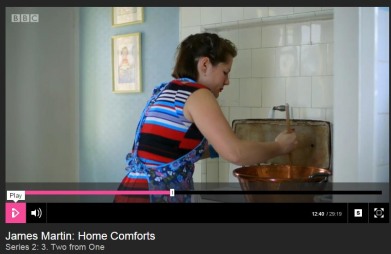
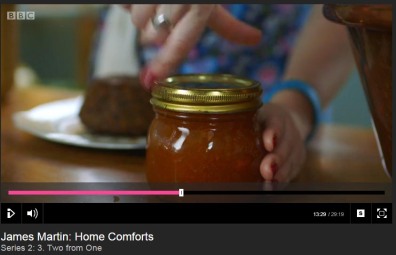
Here is the full clip, which is now up permanently on the James Martin: Home Comforts website, thanks to the lovely BBC listening to all your comments about wanting the recipes and deciding it would be a good idea. Stuffed Lettuces and Kedgeree are also up.
http://www.bbc.co.uk/programmes/p02jtywc/player


